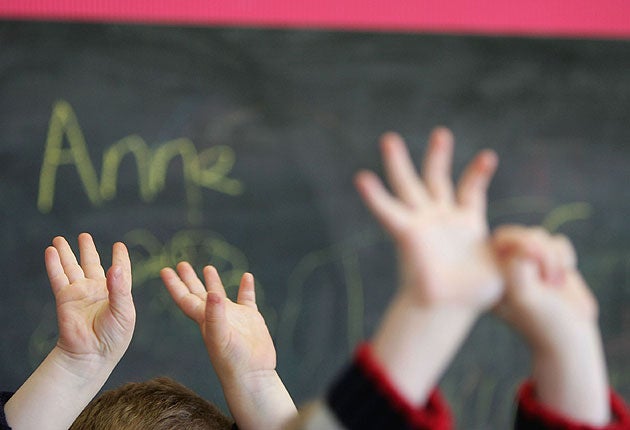Girls 13 Boys 0: Testing reveals gender gap in basic skills
Tests carried out on children before they start school at five show girls are still streets ahead of boys, writes Richard Garner

Your support helps us to tell the story
From reproductive rights to climate change to Big Tech, The Independent is on the ground when the story is developing. Whether it's investigating the financials of Elon Musk's pro-Trump PAC or producing our latest documentary, 'The A Word', which shines a light on the American women fighting for reproductive rights, we know how important it is to parse out the facts from the messaging.
At such a critical moment in US history, we need reporters on the ground. Your donation allows us to keep sending journalists to speak to both sides of the story.
The Independent is trusted by Americans across the entire political spectrum. And unlike many other quality news outlets, we choose not to lock Americans out of our reporting and analysis with paywalls. We believe quality journalism should be available to everyone, paid for by those who can afford it.
Your support makes all the difference.Girls are racing ahead of boys in a whole range of skills, from reading and writing to showing the ability to concentrate before they even start their first day of school. An analysis of the basic assessments carried out on every four-year-old before they start compulsory schooling shows a 20 percentage point gap already emerging in writing ability, with 74 per cent of girls able to use writing for a variety of purposes, compared with just 54 per cent of boys.
For the first time, the Government has published a gender breakdown of boys' and girls' results in the 117 different point scores they can achieve in the assessments. It reveals that boys perform better than girls in only three of the 117 points. They top the scale for mathematical development – attained by 7 per cent of boys and 6 per cent of girls – and are better at getting to grips with new technology and at building and constructing objects. In every other area of the curriculum, however, girls are either streets ahead or equal to boys.
"The fact there is a 20 percentage point gap between boys and girls in some areas of communication skills is worrying," said Anne Mountford, of the children's charity 4Children. "The economy is moving much more towards communications skills and girls seem to be tearing ahead. If we don't act, boys won't be job-ready for the world that is coming."
All pupils at the foundation stage, which ends when they start school at five, are assessed in 13 areas, with nine points on the scale of each assessment, showing what level each child has reached. Assessments range from observing how pupils manage personal hygiene and whether they can dress and undress themselves, to whether they have respect for adults and their peers. While three in four girls can write a simple shopping list or a letter to Father Christmas, only half of boys can do so. In addition, 26 per cent of boys cannot write their own name, compared with 15 per cent of girls.
The other areas where the biggest gap emerged between the sexes were in using imagination – in art, play or drama – where 71 per cent of girls ticked the box compared with 52 per cent of boys.
The test results
All four-year-olds in England were assessed in 13 different areas and could score a maximum of nine points in each.
Dispositions and attitudes
These included monitoring personal hygiene, showing interest in the classroom and how well youngsters dressed and undressed. Girls outperformed boys in seven of the nine points on the assessment scale. Equal on the other two.
Social development
How well they played with others and relationships with adults. Girls won 8-0
Emotional development
Including communicating confidently and respect for others' cultures. Girls 8-0.
Language for communication thinking
Included listening and responding to people and speaking clearly and with confidence. Girls 8-0.
Linking sound and letters
Reciting nursery rhymes, naming and seeing letters of the alphabet, reading simple words. Girls triumphed in all of nine points on the scale.
Reading
Recognising 10 familiar words and simple sentences plus understanding stories. Girls were ahead at seven points on the scale.
Writing
Writing their own name and other words from memory and constructing simple sentences. Girls won 8-0. The biggest gap of all was in this category, with 74 per cent of girls writing for a variety of purposes compared with 54 per cent of boys.
Numbers and counting
Counting reliably up to six everyday objects and recognising numerals from 1 to 9. Girls ahead at eight points.
Calculating
Included adding and subtracting. Boys scored their first triumph, with seven per cent succeeding in the hardest task (which included mental recall) as opposed to six per cent of girls. But girls came out on top at the other eight points.
Shape,space and measure
Using words such as "bigger" and "circle" to describe objects. Girls 8-0 ahead.
Knowledge and understanding of the world
Girls only 4-2 ahead, with boys better at building blocks and understanding technology.
Physical development
Moved with confidence and showed awareness of space. Girls 8-0.
Creative development
Sang simple songs, expressed feelings and preferences about artwork, drama and music. Girls 8-0 with one of the biggest gaps – 19 per cent – in using imagination in art, music, dance and play.
Join our commenting forum
Join thought-provoking conversations, follow other Independent readers and see their replies
Comments